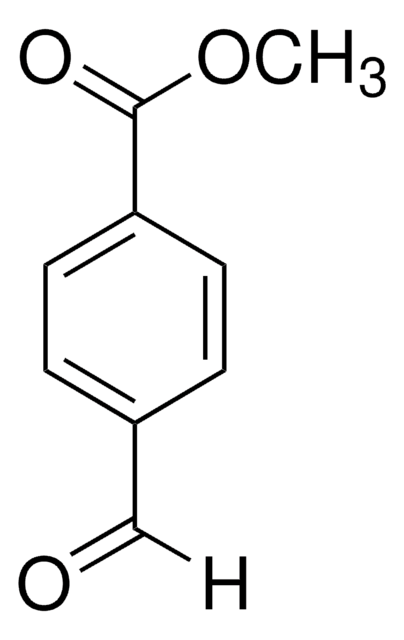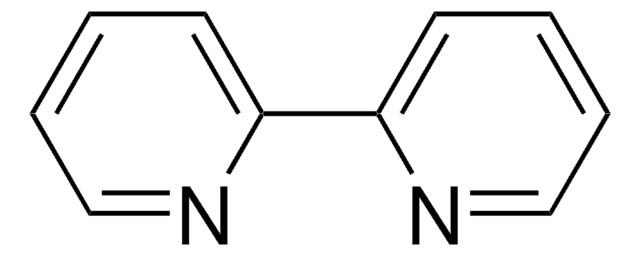Alle Fotos(2)
Wichtige Dokumente
301841
1,7-Phenanthrolin
99%
Anmeldenzur Ansicht organisationsspezifischer und vertraglich vereinbarter Preise
Alle Fotos(2)
About This Item
Empirische Formel (Hill-System):
C12H8N2
CAS-Nummer:
Molekulargewicht:
180.21
MDL-Nummer:
UNSPSC-Code:
12352100
PubChem Substanz-ID:
NACRES:
NA.22
Empfohlene Produkte
Qualitätsniveau
Assay
99%
Form
solid
mp (Schmelzpunkt)
79-81 °C (lit.)
SMILES String
c1cnc2c(c1)ccc3ncccc23
InChI
1S/C12H8N2/c1-3-9-5-6-11-10(4-2-7-13-11)12(9)14-8-1/h1-8H
InChIKey
OZKOMUDCMCEDTM-UHFFFAOYSA-N
Allgemeine Beschreibung
1,7-Phenanthroline has inhibitory effect on germination and growth of plants. 1,7-Phenanthroline is an aza-analog of phenanthrene, was found to be mutagenic in the Ames test using Salmonella typhimurium TA100 in the presence of a rat liver S9 fraction. Supramolecular assemblies of 1,2,4,5-benzenetetracarboxylic acid with 1,7-phenanthroline (aza donor molecule) were investigated.
Signalwort
Danger
H-Sätze
Gefahreneinstufungen
Acute Tox. 3 Oral - Aquatic Acute 1 - Aquatic Chronic 1 - Eye Dam. 1
Lagerklassenschlüssel
6.1C - Combustible acute toxic Cat.3 / toxic compounds or compounds which causing chronic effects
WGK
WGK 3
Flammpunkt (°F)
Not applicable
Flammpunkt (°C)
Not applicable
Persönliche Schutzausrüstung
dust mask type N95 (US), Eyeshields, Faceshields, Gloves
Hier finden Sie alle aktuellen Versionen:
Besitzen Sie dieses Produkt bereits?
In der Dokumentenbibliothek finden Sie die Dokumentation zu den Produkten, die Sie kürzlich erworben haben.
Kunden haben sich ebenfalls angesehen
Veronika Paková et al.
Environmental toxicology and chemistry, 25(12), 3238-3245 (2007-01-16)
N-heterocyclic derivatives of polycyclic aromatic hydrocarbons (NPAHs) are widespread concomitantly with their parent analogues and have been detected in air, water, sediments, and soil. Although they were shown to be highly toxic to some organisms, our understanding of their occurrence
Davide Palma et al.
Materials (Basel, Switzerland), 11(7) (2018-06-29)
The exploitation of organic waste as a source of bio-based substances to be used in environmental applications is gaining increasing interest. In the present research, compost-derived bio-based substances (BBS-Cs) were used to prepare hybrid magnetic nanoparticles (HMNPs) to be tested
Martin Saurer et al.
Science (New York, N.Y.), 365(6458), 1144-1149 (2019-09-14)
Mitochondrial ribosomes (mitoribosomes) are large ribonucleoprotein complexes that synthesize proteins encoded by the mitochondrial genome. An extensive cellular machinery responsible for ribosome assembly has been described only for eukaryotic cytosolic ribosomes. Here we report that the assembly of the small
Wei Xiao et al.
Environmental science & technology, 52(1), 114-123 (2017-12-06)
Iron (oxyhydr)oxides are widespread in natural and engineered systems, potent adsorbents of contaminants and a source of energy for iron-reducing bacteria. Microbial reduction of iron (oxyhydr)oxides results in the formation of Fe(II) which can induce the transformation of these iron
Suyang Tian et al.
Journal of food and drug analysis, 25(4), 766-775 (2017-10-11)
In this study, polysaccharides from Angelica sinensis were extracted using the ultrasound-assisted extraction method. Based on the results of single factor experiments and orthogonal tests, three independent variables-water/raw material ratio, ultrasound time, and ultrasound power-were selected for investigation. Then, we
Unser Team von Wissenschaftlern verfügt über Erfahrung in allen Forschungsbereichen einschließlich Life Science, Materialwissenschaften, chemischer Synthese, Chromatographie, Analytik und vielen mehr..
Setzen Sie sich mit dem technischen Dienst in Verbindung.



